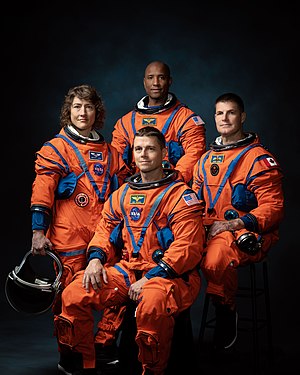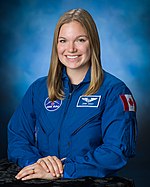Artemis 2 (officially Artemis II)[4] is a scheduled mission of the NASA-led Artemis program. It will use the second launch of the Space Launch System (SLS) and include the first crewed mission of the Orion spacecraft. The mission is scheduled for no earlier than September 2025.[1] Four astronauts will perform a flyby of the Moon and return to Earth, becoming the first crew to travel beyond low Earth orbit since Apollo 17 in 1972. Artemis 2 will be the first crewed launch from Launch Complex 39B of the Kennedy Space Center since STS-116 in 2006.
 Summary of the Artemis 2 mission plan | |
| Names | Artemis 2 Exploration Mission-2 (EM-2) |
|---|---|
| Mission type | Crewed lunar flyby |
| Operator | NASA |
| Mission duration | 10 days (planned) |
| Spacecraft properties | |
| Spacecraft | Orion CM-003 |
| Crew | |
| Crew size | 4 |
| Members | Reid Wiseman Victor Glover Christina Koch Jeremy Hansen |
| Start of mission | |
| Launch date | September 2025 (planned)[1] |
| Rocket | SLS Block 1 |
| Launch site | Kennedy Space Center, LC-39B[2] |
| Contractor | NASA |
| End of mission | |
| Recovered by | U.S. Navy (San Antonio-class amphibious transport dock) |
| Landing date | September 2025 |
| Landing site | Pacific Ocean (planned) |
| Flyby of Moon | |
| Distance | 6,400 mi (10,300 km) (planned)[3] |
 Official Crew Portrait (Clockwise from left) Koch, Glover, Hansen, Wiseman | |
Originally designated Exploration Mission-2 (EM-2), the mission was intended to collect samples from a captured asteroid in lunar orbit by the now-canceled robotic Asteroid Redirect Mission;[5] it was renamed after the introduction of the Artemis program.
History
In 2017, Exploration Mission-2 was a projected single-launch mission of a Space Launch System (SLS) Block 1B with an Exploration Upper Stage, lunar Block 1 Orion spacecraft, and a payload insertion of 50.7 t (55.9 short tons; 112,000 lb). The plan was to rendezvous with an asteroid previously placed in lunar orbit by the robotic Asteroid Redirect Mission and have astronauts perform space-walks and gather samples.[6] After the cancellation in April 2017[7] of the Asteroid Redirect Mission, an 8-day mission was proposed with a crew of four astronauts, sent on a free-return trajectory around the Moon.[8] Another proposal suggested in 2017 was to take four astronauts aboard Orion on an 8-to-21–day trip around the Moon to deliver the first element of the Deep Space Gateway.[9] In March 2018, it was decided to launch the first Gateway module on a commercial launch vehicle[10] because of delays in building the Mobile Launcher needed to hold the more powerful Exploration Upper Stage.[11] The launcher was selected to be the SpaceX Falcon Heavy.[12]

On 11 February 2023, NASA flipped the engine section for the Artemis 2 core to horizontal, the final major milestone before mating the section to the rest of the vehicle. On March 20, the engine section was mated with the Artemis 2 core stage in Building 103 at the Michoud Assembly Facility. NASA expected the core stage, complete with engines, to be delivered to the Kennedy Space Center in summer 2023.[13] In May, the delivery date was moved to late fall 2023.[14][15] The RS-25 engines now installed on the core stage in New Orleans as of September 25, 2023[update] have serial numbers E2047, E2059, E2062, and E2063.[16][17] Finally in June 2024, NASA announced the planned delivery of the fully outfitted core stage to KSC in July 2024.[18]
The crew was announced on April 3, 2023, as stated by NASA Administrator Bill Nelson, in his "State of NASA" speech reacting to President Joe Biden's FY2024 budget proposal.[19] The announcement occurred at a NASA facility at Ellington Field outside Houston.[20] They appeared later that day at nearby NRG Stadium for the 2023 March Madness championship game.[21]
Proposed secondary payloads

NASA's CubeSat Launch Initiative (CSLI) sought proposals in 2019 from U.S. institutions and U.S. companies to fly their CubeSat missions as secondary payloads aboard the SLS on the Artemis 2 mission.[22][23] NASA would accept proposals for both 6-unit (12 kg, 26 lb) and 12-unit (20 kg, 44 lb) CubeSats.[24] As with the Artemis 1 mission, the CubeSats flying on Artemis 2 were to be mounted on the inside of the stage adapter ring between the SLS upper stage and the Orion spacecraft, and will be deployed after Orion separates.[24] Selections were initially planned to be made by February 2020,[22] but in October 2021, NASA dropped all secondary payloads from the mission.[25]
Launch date
During preliminary reviews in 2011, the launch date was placed somewhere between 2019 and 2021, but afterwards the launch date was delayed to 2023.[26][27] As of January 2024[update], the mission is expected to launch no earlier than September 2025.[1]
Crew
| Position | Astronaut | |
|---|---|---|
| Commander |  Reid Wiseman, NASA Reid Wiseman, NASASecond spaceflight | |
| Pilot |  Victor Glover, NASA Victor Glover, NASASecond spaceflight | |
| Payload Specialist |  Christina Koch, NASA Christina Koch, NASASecond spaceflight | |
| Mission Specialist |  Jeremy Hansen, CSA Jeremy Hansen, CSAFirst spaceflight | |

Artemis 2 is to be crewed by four astronauts: Commander Reid Wiseman, Pilot Victor J. Glover, Payload Specialist Christina Koch, and Mission Specialist Jeremy Hansen.[28] Jenni Sidey-Gibbons is Hansen's backup; she will join the mission if Hansen is unable to do so.[29][30]
Glover, Koch, and Hansen are to be the first person of color, woman, and non-American to go beyond low Earth orbit respectively.[28] Hansen and Sidey-Gibbons are Canadian and have been assigned by the Canadian Space Agency;[28] a 2020 treaty between the United States and Canada led to their involvement.[31]

Mission

The Artemis 2 mission plan is to send four astronauts in the first crewed Orion MPCV spacecraft into a lunar flyby for a maximum of 21 days using the Block 1 variant of the Space Launch System. The mission profile is a multi-trans-lunar injection (MTLI), or multiple departure burns, and includes a free-return trajectory from the Moon. The Orion spacecraft will be sent to a high Earth orbit with a period of roughly 24 hours. During this time the crew will perform various checkouts of the spacecraft's life support systems as well as an in-space rendezvous and proximity operations demonstration using the spent Interim Cryogenic Propulsion Stage (ICPS) as a target. When Orion reaches perigee once again, it will fire its main engine to complete the TLI maneuver, which will send it to a lunar free-return trajectory, before returning to Earth.[3][32]
Optical communications

Artemis 2 will test and demonstrate optical communications to and from Earth using the Orion Artemis II Optical Communications System (O2O).[33] The O2O hardware will be integrated into the Orion spacecraft and includes an optical module (a 4-inch [100 mm] telescope and two gimbals), modem and control electronics.[33] O2O will communicate with ground stations in California and New Mexico.[33] The test device will send data to Earth with a downlink rate of up to 260 megabits per second.[34]
Artemis Trajectory Overview
Artemis 2's trajectory can be divided into several key phases[35]
1. Launch Phase
- Vehicle: Space Launch System (SLS) Block 1
- Launch Site: Kennedy Space Center, Launch Complex 39B
- Duration: Approximately 8 minutes to reach initial orbit
- Trajectory: The SLS will launch Orion into a low Earth orbit (LEO).
2. Earth Orbit and Systems Checkout
- Orbit: Low Earth Orbit (LEO)
- Duration: About 24 hours
- Activities: The crew will perform checks on the Orion spacecraft’s systems, ensuring all are functioning correctly before proceeding with the mission.
3. Translunar Injection (TLI)
- Maneuver: After the systems checkout, the Orion spacecraft will perform a TLI burn using its Service Module, propelling it out of Earth orbit towards the Moon.
- Trajectory: A precise burn to place Orion on a trajectory that will take it around the Moon.
4. Lunar Flyby
- Altitude: Closest approach approximately 7,400 kilometers (about 4,600 miles) from the lunar surface.
- Duration: Several days to travel to the Moon, fly around it, and begin the return trip.
- Activities: The crew will continue to monitor and test Orion’s systems and gather data on deep space travel effects.
5. Return Trajectory
- Maneuver: After the lunar flyby, Orion will use the Moon’s gravity to assist in its return to Earth, a maneuver known as a free-return trajectory.
- Trajectory: A path that will naturally bring Orion back to Earth without the need for additional propulsion if systems fail.
6. Re-entry and Splashdown
- Re-entry Phase: Orion will re-enter Earth's atmosphere.
- Splashdown: In the Pacific Ocean, recovery teams will retrieve the spacecraft and crew.
- Duration: The entire mission is expected to last about 10 days.
Similar missions
In December 1968, the Apollo 8 mission, crewed by astronauts Frank Borman, Jim Lovell, and William Anders, flew their command and service module beyond low Earth orbit and completed ten orbits of the Moon. Similar to the planned Artemis 2 mission in that it was crewed and did not land, it differed by being placed into orbit.[36] Apollo 13 (1970) was the only Apollo mission, and only crewed spaceflight to date, that flew past the Moon by a free-return trajectory.
References
External links

- Artemis II, at NASA
- Mission Overview, at NASA